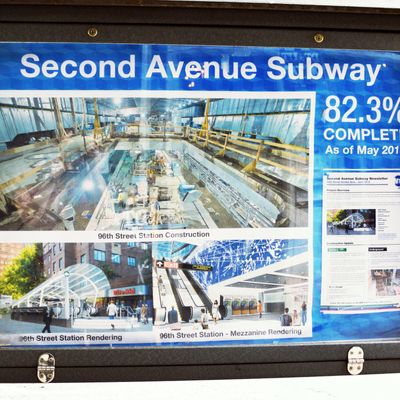
Recently, I was walking with a friend, when we passed a sign for the long-delayed Second Avenue subway. On it, big white letters declared the project to be “82.3% COMPLETE.” The hyperspecificity of this figure cracked us up. Why not round up or down? And what could possibly account for that missing 0.7 percent?
The actual, MTA-approved answer is, sadly, not that interesting. The completion percentage is calculated by subtracting the amount paid out for equipment and labor from the total budget, the same way it goes for virtually every construction or engineering project. It’s that precise simply because it’s possible to be that precise.
But, though it may be unintentional, the extreme precision of a percentage like that could be helping public perception of the project, which is expected to be completed by the end of 2016. (Someone should tell this to Peggy Olson’s realtor.) There’s some interesting psychology here about what people perceive when they see or hear a specific figure like this one, said Dan Ariely, Duke University behavioral economist and best-selling author. Essentially, the specificity might quietly nudge people into taking the claim more seriously, he said. “So what happens if I say Let’s meet at 7, versus what happens if I say, Let’s meet at 7:01? What happens is that you infer a very different resolution from that,” Ariely said. If someone tells you to meet them at 7:01, he explained, you’ll be more likely to assume that it’s important to them that you arrive on time than if they’d suggested 7 or 7-ish.
In his new book, Irrationally Yours, a collection of Q&As culled from Ariely’s popular advice column for The Wall Street Journal, Ariely explores this idea, answering a question from a man who encountered a panhandler asking for exactly 75 cents. Not spare change, not a few dollars — 75 cents. “In the same way, a request for exactly 75 cents may carry with it a set of inferences about how seriously the person needs the money,” Ariely writes in the book. “This very specific request may lead us to think that there is a particular reason for the request — like getting money for bus fare — and we are more likely to help when the need is specific.” It’s kind of like the reason many people turn on the battery percentage feature on their iPhones. Seeing that your battery is at 23 percent probably makes you more likely to find a charger than if you saw it was low-ish, but not quite dead yet.
By the way, the hyperspecific number has climbed since I saw it last. “The current percentage is 83.4,” Ortiz noted, “up a bit from when you saw the sign.”

